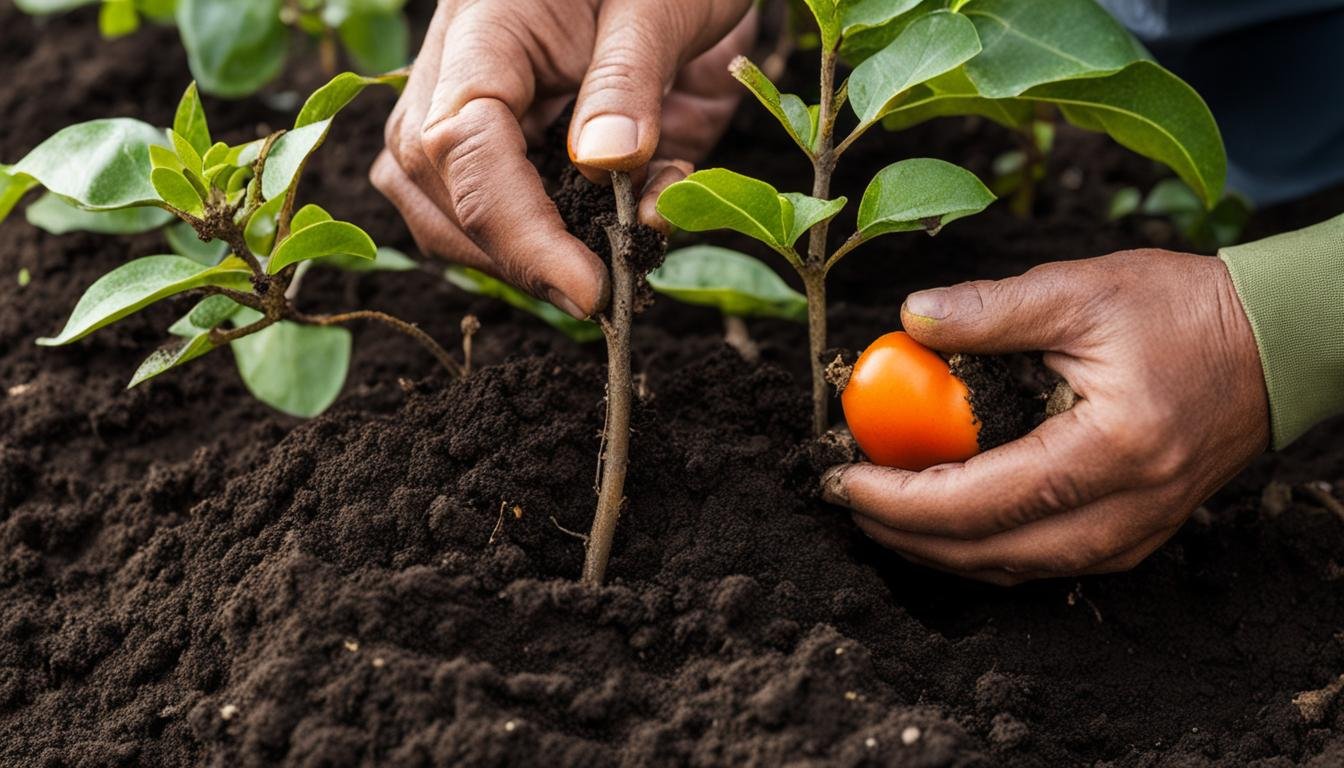Greetings! I’m here to share my knowledge and expertise on planting persimmon trees. These versatile gems have the power to transform any garden into a vibrant haven. Whether you’re a seasoned gardener or just starting out, these tips will help you successfully plant and nurture your persimmon trees.
Key Takeaways:
- Choose a sunny site with well-drained soil for optimal growth.
- Spring or fall is the best time to plant persimmon trees for optimal root growth.
- American persimmons (Diospyros virginiana) are native to the United States and can grow up to 33 feet.
- Japanese persimmons (Diospyros kaki) originate from East Asia and have glossy, bluish-green leaves.
- Persimmon trees are dioecious, meaning they have separate male and female trees.
- Regular watering and balanced fertilization are crucial for the healthy growth of persimmon trees.
- Harvest persimmons when fully ripe for the best flavor.
Types of Persimmon Trees
When considering planting persimmon trees, it’s important to know the different types available. The two most popular varieties are the American persimmon (Diospyros virginiana) and the Japanese persimmon (Diospyros kaki). Let’s take a closer look at each:
American Persimmon
The American persimmon is native to the United States and is known for its hardy nature. These trees can reach heights of up to 60 feet, making them a great addition to larger gardens or spacious landscapes. American persimmons have separate male and female trees, with the female trees bearing the delicious fruit. The fruit is typically round and ranges in color from orange to maroon. It’s important to note that American persimmons can be a bit messy when harvested, as the ripe fruit tends to drop from the tree.
Japanese Persimmon
Originating from East Asia, the Japanese persimmon is another popular choice for gardeners. These trees have glossy, bluish-green leaves and can grow up to 60 feet in height. The fruit produced by Japanese persimmons is more circular in shape compared to the American variety. It starts off green and then turns orange as it ripens. Japanese persimmons are known for their sweet and flavorful taste, making them a favorite among fruit enthusiasts.
“The different types of persimmon trees offer unique characteristics and flavors. Whether you prefer the hardy American persimmon or the sweet Japanese variety, these trees can make a beautiful addition to any garden.” – Gardening Enthusiast
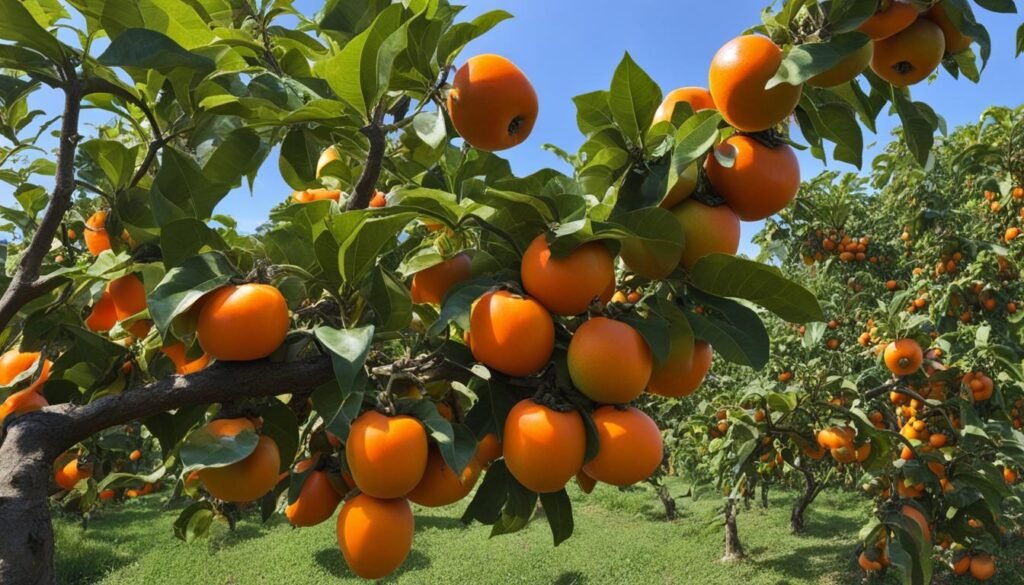
Table: Comparison of Persimmon Tree Characteristics
| Species | Size | Leaves | Bark |
|---|---|---|---|
| American Persimmon | Up to 10 meters | Dark green, turns yellow and orange in fall | Gray to brown with distinctive ridges |
| Japanese Persimmon | 4.5 to 18 meters | Dark green, turns yellow and orange in fall | Gray to brown with distinctive ridges |
Flowers and Fruits
When it comes to persimmon trees, their beauty extends beyond their leaves and bark. These trees produce delicate flowers that add a touch of elegance to any garden. The flowers of persimmon trees are small in size and can come in white or greenish-white colors. They may not be as showy as some other flowering trees, but their subtle charm is undeniable.
As the flowers fade away, they give rise to the main attraction of persimmon trees – the fruit. Persimmon fruit comes in different sizes and colors, depending on the species. American persimmons typically have fruits that measure around 2 inches in diameter and range from dark red to maroon. Japanese persimmons, on the other hand, produce fruit that is more circular in shape and can vary in color from yellow-orange to deep orange.
“The fruit of a persimmon tree is initially astringent, but becomes sweet and flavorful once fully ripe.”
It’s important to note that persimmon trees are dioecious, meaning they have separate male and female trees. The female trees are the ones that bear fruit, while the male trees produce pollen to fertilize the female flowers. This pollination process is often carried out by wind or bees, ensuring that the fruit develops and matures properly.
Persimmon Tree Fruit
| Species | Fruit Size | Fruit Color |
|---|---|---|
| American Persimmon | Around 2 inches in diameter | Dark red to maroon |
| Japanese Persimmon | Varies | Yellow-orange to deep orange |
The persimmon fruit is initially astringent, meaning it has a dry and puckering effect on the mouth. However, as the fruit ripens, it becomes sweeter and more flavorful. It’s important to harvest persimmons when they are fully ripe to enjoy their delicious taste. American persimmons often drop their ripe fruit, while Japanese persimmons can be picked when slightly firm and allowed to ripen indoors.
Once harvested, persimmons can be enjoyed fresh or used in a variety of culinary creations. They can be sliced into salads, baked into pies and cakes, made into jams and jellies, or even dried for a tasty snack. The versatility of persimmon fruit makes it a delightful addition to any kitchen.
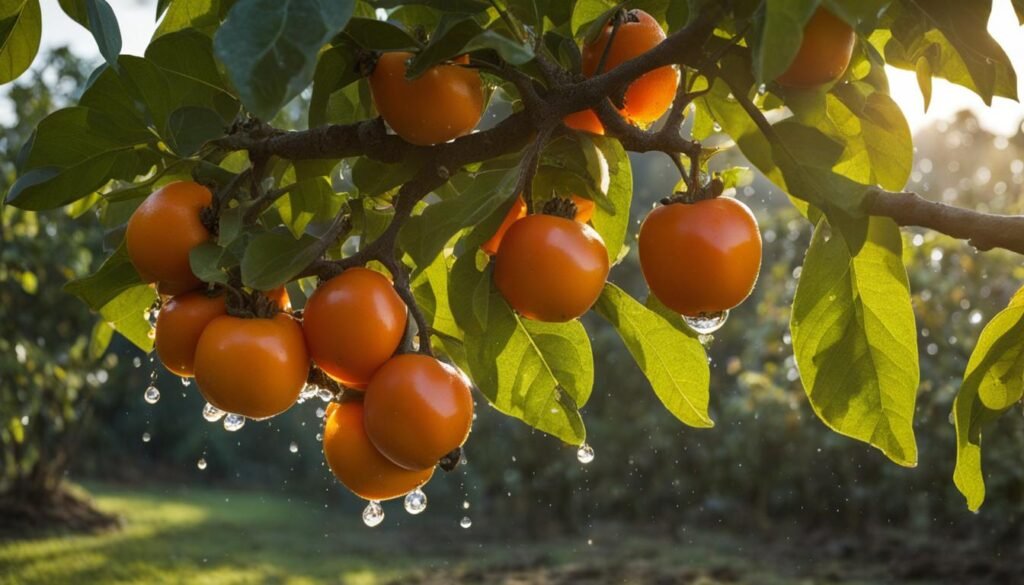
| Soil Requirements | Sun Exposure | Watering | Fertilizer | |
|---|---|---|---|---|
| American Persimmon | Tolerates a variety of soil types | Full sun | Regular watering, especially when young | Balanced slow-release fertilizer in early spring |
| Japanese Persimmon | Tolerates a variety of soil types | Full sun | Regular watering, especially when young | Balanced slow-release fertilizer in early spring |
Proper watering is crucial for the establishment and growth of persimmon trees.
By providing the right soil conditions, sun exposure, and regular watering and fertilization, you can create an optimal environment for your persimmon trees to thrive. Remember to monitor the moisture levels and adjust watering accordingly, especially during hot and dry periods. With proper care and attention, you’ll be rewarded with healthy trees and delicious persimmons for years to come.
Propagation and Pollination
Growing persimmon trees can be an exciting endeavor, but it’s important to understand the process of propagation and pollination to ensure successful growth and fruit production.
Propagation:
There are two primary methods of propagating persimmon trees: root cuttings and seed germination. Root cuttings involve taking a section of the tree’s root system and planting it in a suitable growing medium. This method can be time-consuming and requires patience, as it can take several years for the cutting to develop into a mature tree. Seed germination is another option, where persimmon seeds are stratified to mimic the winter dormancy period. The stratified seeds are then planted in late spring when the soil temperatures warm up. This method allows for a higher success rate in terms of tree establishment, but it’s important to note that persimmons grown from seeds may exhibit variations in fruit quality and characteristics.
Pollination:
Persimmon trees can be categorized as self-pollinating or cross-pollinating. Self-pollinating trees have both male and female flowers on the same tree, allowing for successful pollination and fruit set without the need for a pollinator. However, cross-pollination with multiple persimmon trees can result in larger yields and better fruit quality. Bees and wind play a crucial role in transferring pollen between flowers, so it’s essential to have other persimmon tree varieties nearby to enhance cross-pollination. When selecting pollinators, choose trees that flower at the same time to ensure synchronization. Additionally, consider the compatibility of the persimmon varieties and their pollen viability to maximize pollination success.
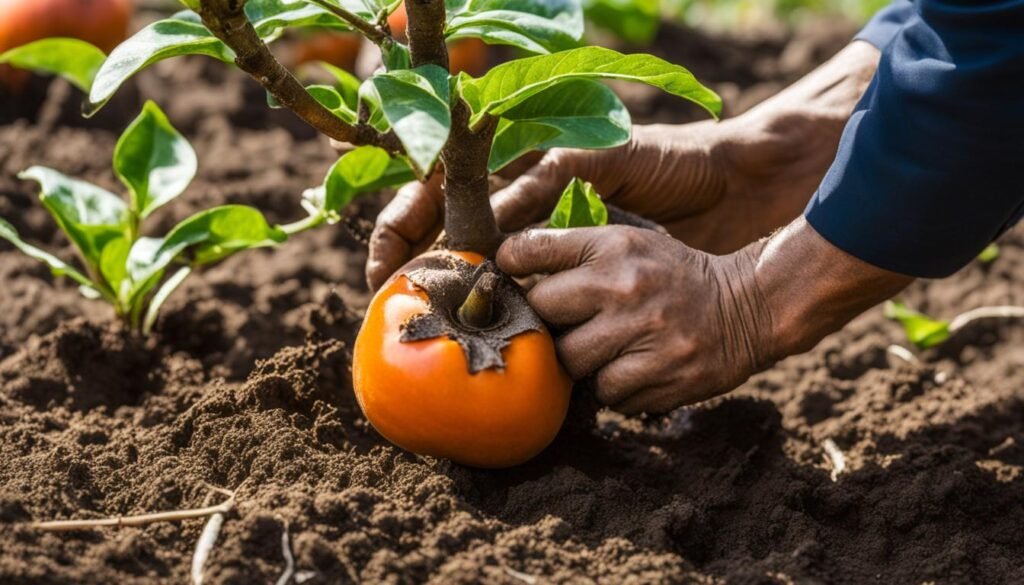
| Propagation Method | Advantages | Disadvantages |
|---|---|---|
| Root Cuttings | – Allows for the propagation of specific cultivars – Can result in faster tree establishment compared to seed germination |
– Time-consuming process – Requires patience as it can take several years for the cutting to develop into a mature tree |
| Seed Germination | – Provides a higher success rate for tree establishment – Allows for the potential discovery of new persimmon varieties |
– Variability in fruit quality and characteristics – Requires stratification and careful timing for optimal germination |
Understanding the propagation and pollination requirements of persimmon trees is crucial for successful cultivation. By selecting the appropriate propagation method and ensuring proper cross-pollination, you can enjoy the beauty of these trees and the abundance of their delicious fruit.
Fruit Harvesting and Usage
Harvesting persimmons at the right time is crucial to enjoy their delicious flavor. American persimmons (Diospyros virginiana) often drop their ripe fruit, so keep an eye on the ground for fallen persimmons. Asian persimmons (Diospyros kaki) can be picked when slightly firm, as they soften and ripen off the tree.
When harvesting persimmons, it’s important to wait until they are fully ripe. Eating unripe persimmons can result in an unpleasant, astringent taste. The fruit should be soft and have a sweet aroma. To check for ripeness, gently press the fruit with your fingers – it should yield to gentle pressure.
Persimmons can be enjoyed in various ways. They can be eaten fresh, sliced into salads, or incorporated into a range of recipes. The sweet and flavorful flesh of ripe persimmons adds a unique touch to desserts, such as pies, tarts, and cakes. Persimmons can also be blended into smoothies or made into jams and preserves.
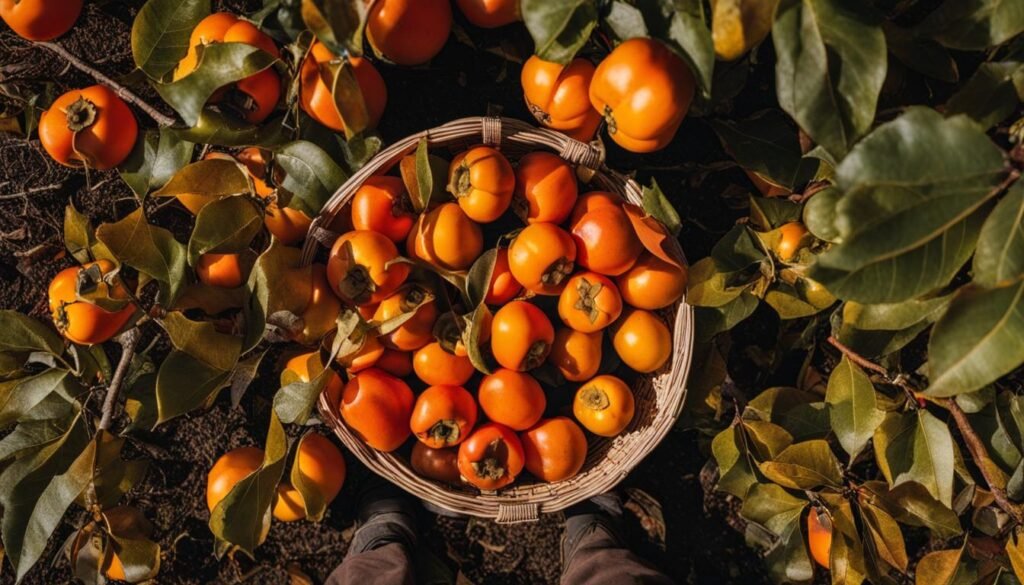
| Uses for Persimmon Fruits | Description |
|---|---|
| Fresh Consumption | Eating ripe persimmons as a healthy snack |
| Salads | Slicing persimmons and adding them to green salads or fruit salads |
| Desserts | Incorporating persimmons into pies, tarts, cakes, and other sweet treats |
| Smoothies | Blending persimmons with other fruits for a refreshing beverage |
| Jams and Preserves | Processing persimmons into delicious spreads to enjoy throughout the year |
With their unique flavor and versatility, persimmons are a delightful addition to any kitchen. Experiment with different recipes and discover new ways to savor the bountiful harvest of persimmons.
Selecting the Right Persimmon
Choosing the right persimmon variety is crucial for successful cultivation. Factors such as climate requirements and personal preferences should be taken into account. In the United States, there are two main types of persimmons to consider: American persimmons (Diospyros virginiana) and Asian persimmons (Diospyros kaki).
American persimmons are hardy and can tolerate both cold and mild winter regions, ranging from Zones 5 to 9. They are a great choice for gardeners in various climates. On the other hand, Asian persimmons thrive in mild winter regions, typically Zones 7 to 10. These regions offer the ideal conditions for Asian persimmons to flourish and produce abundant fruit.
When selecting a persimmon variety, it’s important to consider the local climate and choose a tree that is well-suited to the conditions. This will ensure optimal growth and fruit production. If you live in a colder region, opt for an American persimmon variety. If you reside in a milder area, an Asian persimmon variety would be a better choice.
| Persimmon Variety | Climate Requirements |
|---|---|
| American Persimmon (Diospyros virginiana) | Cold and mild winter regions (Zones 5-9) |
| Asian Persimmon (Diospyros kaki) | Mild winter regions (Zones 7-10) |
By selecting the right persimmon variety for your climate, you can ensure a thriving tree that will provide you with delectable fruit for years to come.
Planting and Care Tips
When it comes to planting and caring for persimmon trees, there are a few key tips to keep in mind. First and foremost, choose a sunny location for your tree. Persimmons thrive in full sun, so find a spot in your garden that receives at least 6 to 8 hours of direct sunlight each day. This will ensure that your tree gets the energy it needs to grow and produce fruit.
Next, make sure you select well-drained soil for your persimmon tree. These trees do not tolerate wet or waterlogged soil, so it’s important to choose a location with good drainage. If your soil is heavy or tends to retain water, you can amend it with organic matter such as compost or peat moss to improve drainage.
Once your persimmon tree is planted, regular watering is crucial, especially during the first year. Keep the soil consistently moist but not waterlogged. Overwatering can lead to root rot, so it’s important to strike the right balance. As your tree matures, it will become more drought-tolerant, but it’s still important to provide adequate water during hot, dry periods.
Pruning is also an essential part of caring for persimmon trees. Prune your tree in late winter or early spring before new growth begins. Remove any dead, damaged, or crossing branches to improve airflow and reduce the risk of disease. It’s also a good idea to thin out the branches to allow more light into the canopy, which can help improve fruit production.

Pruning Tips for Persimmon Trees
When pruning your persimmon tree, it’s important to follow a few specific guidelines. Start by sanitizing your pruning tools with rubbing alcohol or a 10% bleach solution to prevent the spread of disease. Make clean, smooth cuts just outside the branch collar, which is the swollen area where the branch attaches to the trunk.
Remove any suckers or water sprouts that emerge from the base of the tree. These shoots are vigorous but often unproductive, so it’s best to remove them to redirect the tree’s energy towards fruit production. Also, thin out the interior branches to improve airflow and light penetration. This will help reduce the risk of fungal diseases and improve the quality of the fruit.
By following these planting and care tips, you can ensure that your persimmon tree thrives and produces a bountiful harvest of delicious fruit. Remember to provide ample sunlight, well-drained soil, regular watering, and proper pruning. With a little TLC, your persimmon tree will reward you with years of beauty and tasty treats.
| Persimmon Planting and Care Tips | |
|---|---|
| Planting Tips | Care Tips |
|
|
Conclusion
I hope this guide has provided you with valuable tips for planting persimmon trees. With the right selection, proper planting techniques, and ongoing care, you can create a thriving persimmon tree in your garden. Remember to choose a variety that is suitable for your climate and provide the optimal growing conditions, including well-drained soil and ample sunlight.
Regular watering and fertilization will help your persimmon tree establish strong roots and promote healthy growth. Additionally, pruning your tree will ensure its shape and remove any dead or unwanted branches. Consider training your persimmon tree as an espalier for a unique and space-saving approach.
By following this persimmon tree planting guide, you’ll be rewarded with a bountiful harvest of delicious persimmons. Whether you enjoy them fresh, incorporate them into recipes, or share them with friends and family, persimmons are a delightful addition to any garden. So, roll up your sleeves, grab your gardening tools, and embark on a wonderful journey into the enchanting world of persimmon trees. Happy planting!
FAQ
Can persimmon trees be grown in any garden?
Yes, persimmon trees are versatile and can be planted in most gardens. However, it’s important to select a sunny site with well-drained soil for optimal growth.
When is the best time to plant persimmon trees?
It is best to plant persimmon trees in the spring or fall, as these seasons provide optimal conditions for root growth.
Are there different types of persimmon trees?
Yes, there are different types of persimmon trees. The most common ones are American persimmons (Diospyros virginiana) and Japanese persimmons (Diospyros kaki).
How tall do persimmon trees grow?
American persimmons can grow up to 33 feet, while Japanese persimmons can reach up to 60 feet in height.
How do I know if a persimmon tree is male or female?
Persimmon trees are dioecious, meaning they have separate male and female trees. The female trees produce edible fruit, while the male trees do not.
How do I care for a persimmon tree?
Persimmon trees prefer slightly acidic and well-drained soil. They should be watered regularly, especially when young, and fertilized with a balanced slow-release fertilizer in early spring. Pruning is important for maintaining shape and removing dead wood.
Can I grow a persimmon tree from a seed?
Yes, persimmon trees can be grown from seeds. They can also be propagated through root cuttings.
When should I harvest persimmons?
Persimmons should be harvested when fully ripe. American persimmons often drop their ripe fruit, while Japanese persimmons can be picked when slightly firm.
What can I do with persimmon fruit?
Persimmons can be eaten fresh, sliced into salads, or used in various recipes such as desserts and jams.
How do I select the right persimmon tree for my area?
Consider the climate in your area when selecting a persimmon tree. Asian persimmons are best suited for mild winter regions (Zones 7-10), while American persimmons can tolerate both cold and mild winter regions (Zones 5-9).
What are some planting and care tips for persimmon trees?
Choose a sunny location with well-drained soil and enough space for the tree to grow to maturity. Water regularly, especially when young, and fertilize with a balanced slow-release fertilizer. Pruning is important for maintaining shape and removing dead wood. Persimmon trees can also be trained as espaliers.
